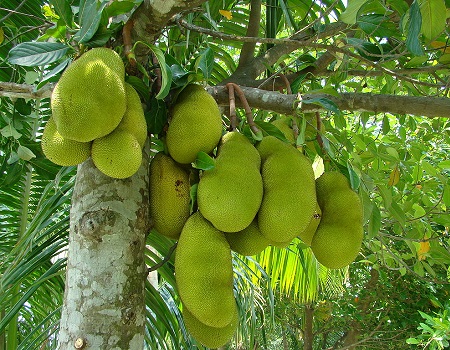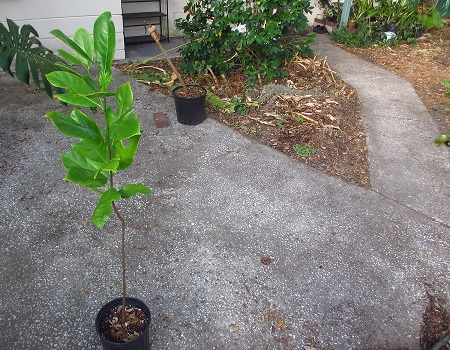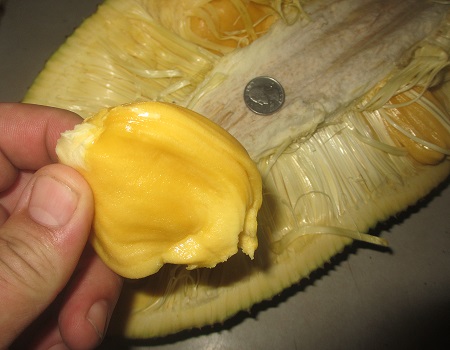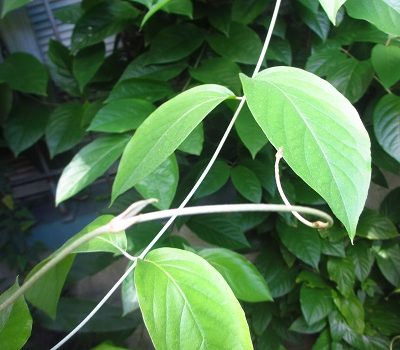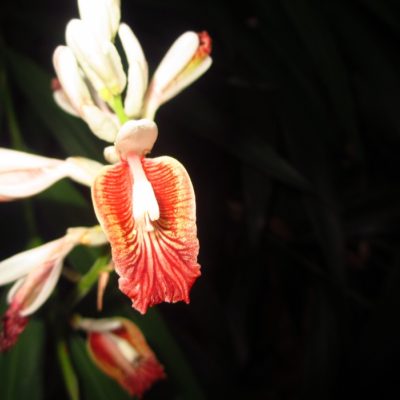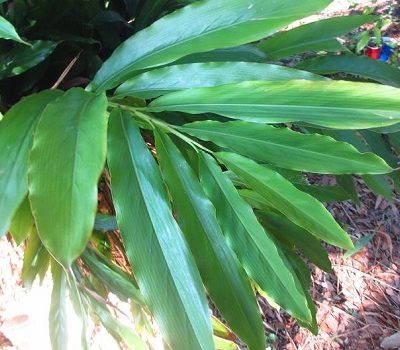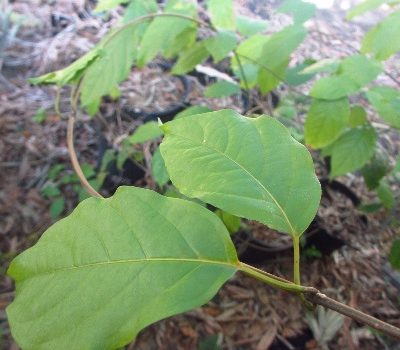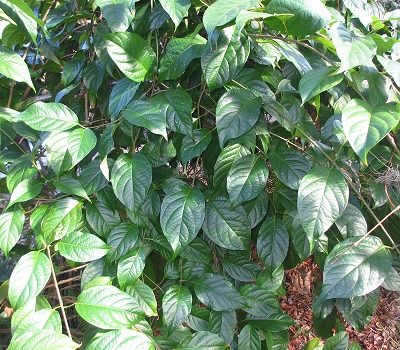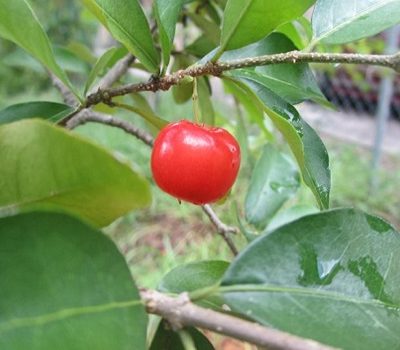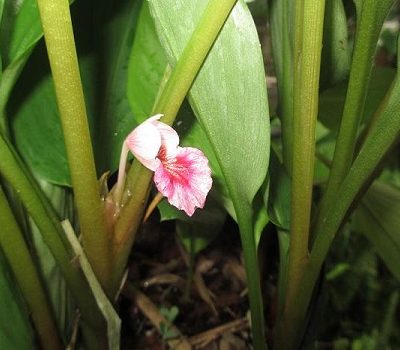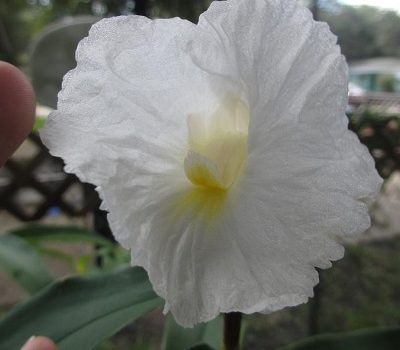The jackfruit tree fruit is the largest tree-borne fruit, reaching as much 120 lbs. The ripe and unripe fruit and seeds are consumed. Jackfruit has a distinctive sweet and fruity aroma. Generally speaking, there are two varieties, which are the “hard” version (crunchier, drier, and less sweet, but fleshier), and the “soft” version (softer, moister, and much sweeter, with a darker gold-color flesh than the hard variety).
Unripe jackfruit has a mild flavor and meat-like texture and is used in curry dishes with spices in many cuisines.
Origin
India
Family
Moraceae
Binomial nomenclature
Artocarpus heterophyllus
Common names
Jakfruit
Description
Artocarpus heterophyllus grows as an evergreen tree that has a relatively short trunk with a dense treetop. It easily reaches heights of 10 to 20 meters and trunk diameters of 30 to 80 centimeters. It sometimes forms buttress roots. The bark of the jackfruit tree is reddish-brown and smooth. In the event of injury to the bark, a milky juice is released. The leaves are alternate and spirally arranged. They are gummy and thick and are divided into a petiole and a leaf blade. The petiole is 1 to 3 inches long. The leathery leaf blade is 7 to 15 inches long, and 3 to 7 inches wide and is oblong to ovate in shape.
In young trees, the leaf edges are irregularly lobed or split. On older trees, the leaves are rounded and dark green, with a smooth leaf margin. The leaf blade has a prominent main nerve and starting on each side six to eight lateral nerves. The stipules are egg-shaped at a length of 1.5 to 8 centimeters.
Jakfruit trees are cauliflorous, meaning that the inflorescences are formed on the trunk, branches or twigs. Jackfruit trees are monoecious, that is there are both female and male flowers on a tree. The inflorescences are pedunculated, cylindrical to ellipsoidal or pear-shaped, to about 10-12 centimeters long and 5-7 centimeters wide.
Inflorescences are initially completely enveloped in egg-shaped cover sheets which rapidly slope off.
The flowers are very small, there are several thousand flowers in an inflorescence, which sit on a fleshy rachis .[22] The male flowers are greenish, some flowers are sterile. The male flowers are hairy and the perianth ends with two 1 to 1.5 millimeters membrane. The individual and prominent stamens are straight with yellow, roundish anthers. After the pollen distribution, the stamens become ash-gray and fall off after a few days. Later all the male inflorescences also fall off. The greenish female flowers, with hairy and tubular perianth, have a fleshy flower-like base. The female flowers contain an ovary with a broad, capitate or rarely bilobed scar. The blooming time ranges from December until February or March.
The ellipsoidal to roundish fruit is a multiple fruit formed from the fusion of the ovaries of multiple flowers. The fruits grow on a long and thick stem on the trunk. They vary in size and ripen from an initially yellowish-greenish to yellow, and then at maturity to yellowish-brown. They possess a hard, gummy shell with small pimples surrounded with hard, hexagonal tubercles. The very large and variously shaped fruit have a length of 30 to 100 centimeters and a diameter of 15 to 50 centimeters and can weigh 10-25 kilograms or more.
The fruits consist of a fibrous, whitish core (rachis) about 5-10 centimeters thick. Radiating from this are many 10 centimeter long individual fruits. They are elliptical to egg-shaped, light brownish achenes with a length of about 3 centimeters and a diameter of 1.5 to 2 centimeters.
There may be about 100-500 seeds per fruit. The seed coat consists of a thin, waxy, parchment-like and easily removable testa (husk) and a brownish, membranous tegmen. The cotyledons are usually unequal in size, the endosperm is minimally present.
The fruit matures during the rainy season from July to August. The bean-shaped achenes of the jackfruit are coated with a firm yellowish aril (seed coat, flesh), which has an intense sweet taste at maturity of the fruit. [3] The pulp is enveloped by many narrow strands of fiber (undeveloped perianth), which run between the hard shell and the core of the fruit and are firmly attached to it. When pruned, the inner part (core) secretes a very sticky, milky liquid, which can hardly be removed from the skin, even with soap and water. To clean the hands after “unwinding” the pulp an oil or other solvent is used. For example, street vendors in Tanzania, who sell the fruit in small segments, provide small bowls of kerosene for their customers to cleanse their sticky fingers.
(Wikipedia)
Height
100 feet tall in the tropics.
Temperature/Zone
zone 10, 36°F. This plant prefers humid conditions. I am successfully growing jakfruit in Tampa FL in zone 9b, but I have to agressivley protect it in Winter. This tree will die at or below freezing.
Light
Full sun
Water
Jakfruit like constant moisture, but standing water will rot their roots
Fertilizer
I use granular 10-10-10, once a month during the warm months
Cultivation
Plant the tree in very rich, well draining soil. Amending the soil with a lot of organic matter is recommended at planting. Jakfruit is a fast growing tree.
Pests
I have not found any pests to be a problem for this plant in Florida.

